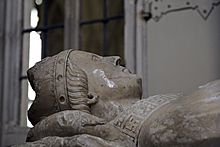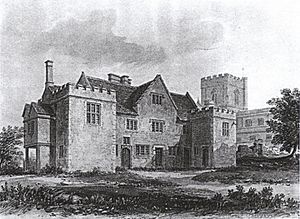William Edington facts for kids
Quick facts for kids William Edington |
|
|---|---|
| Bishop of Winchester | |

Effigy of William Edington in Winchester Cathedral.
|
|
| Province | Canterbury |
| Appointed | 9 December 1345 |
| Reign ended | 6 or 7 October 1366 |
| Predecessor | Adam Orleton |
| Successor | William of Wykeham |
| Other posts | |
| Orders | |
| Consecration | 14 May 1346 |
| Personal details | |
| Died | 6 or 7 October 1366 Bishop's Waltham |
| Buried | Winchester Cathedral |
| Nationality | English |
| Denomination | Roman Catholic |
| Previous post | Keeper of the wardrobe |
William Edington (died in 1366) was an important English leader. He was a bishop and also worked for the King. From 1346 until his death, he was the Bishop of Winchester. He also held several big jobs for the King. These included being the King's "Keeper of the Wardrobe" (in charge of royal money and supplies) and the "Lord High Treasurer" (in charge of the country's money). Later, he became the "Lord Chancellor" (a top government official).
Edington made many important changes to how the government handled money. His work helped England become stronger in the early parts of the Hundred Years' War. As Bishop of Winchester, he started a large rebuilding project at Winchester Cathedral. He also founded Edington Priory, a special church that is still standing today.
Working for the King
William Edington was born in a place called Edington in Wiltshire. His parents were Roger and Amice. Some people thought he went to Oxford University, but there is no clear proof.
His first important helper was Gilbert Middleton. Middleton was a leader at Oxford and also advised the King. When Middleton died, Edington started working for Middleton's friend, Adam Orleton. Orleton was the Bishop of Winchester.
Through Bishop Orleton, King Edward III noticed Edington's skills. In 1341, the King made Edington the "keeper of the wardrobe." This was a very important job. The wardrobe was like the King's personal bank. It held money and supplies, especially when the King was away fighting wars. King Edward wanted to keep control of this money.
The King was very impressed with Edington. In 1344, he made Edington the "treasurer" of the whole country. Edington held this job for a long time, twelve years! This was a difficult job because England was having money problems. The country was deeply in debt because of the early costs of the Hundred Years' War.
The King had broken promises about paying back money. This made it hard for him to borrow more. Edington saw that all the King's spending needed to be watched by the "exchequer" (the government's money department). He didn't try to stop the King from spending. Instead, he worked to plan out all the income and expenses. By the early 1360s, he had largely achieved this goal. This shows how skilled and hardworking Edington was. In 1356, he became "chancellor," another very high position. He held this job until 1363, when he retired from working for the King. He might have retired because he was not feeling well.
Church Career
William Edington also had many important jobs in the church. After his education, he worked as a "rector" (a church leader) in several towns in Northamptonshire. These included Cottingham, Dallington, and Middleton Cheney.
In 1335, Bishop Orleton gave Edington the job of rector at Cheriton, Hampshire. From 1335 to 1346, Edington was also the master of the Hospital of St Cross in Winchester. The King also wanted to reward his good helper. In 1341, Edington received a "prebend" (a payment from a church) from Leighton Manor. By 1344, he had another from Netheravon. By 1345, he had one from Putston. Having many church jobs at once was common back then.
His biggest church job came in 1345. The Pope, at the King's request, made Edington the Bishop of Winchester. This was the richest church position in England. It was thought to be second only to the archbishopric of Milan in Italy.
The monks of Winchester had already chosen their own bishop. But this choice was overturned, and Edington became bishop in 1346. As a bishop, he was often away because of his work for the King. Even so, he did not completely ignore his church duties. He used his position to help his family, which was called "nepotism." He also started big building projects on the main part of Winchester Cathedral.
In 1351, he founded a special church called an Augustinian priory in his hometown of Edington. He wanted prayers to be said there for himself, his parents, and his brother. Most of the priory buildings are gone now. But the church itself still stands. It is a great example of how church building styles changed during that time.
Edington was the very first "Prelate" (a high-ranking church official) of the Order of the Garter. This important group was started in 1348. Since then, every Bishop of Winchester has held this same job.
In May 1366, King Edward wanted to show his thanks one last time. He had Edington chosen to be the Archbishop of Canterbury. This was an even higher church position. However, Edington said no. He said it was because of his poor health. He also famously said that "Canterbury is the higher Rack, but Winchester is the better Manger." This meant that Canterbury was a greater honor, but Winchester gave him more money!
Five months later, on October 6 or 7, 1366, he died in Bishop's Waltham. He is buried in Winchester Cathedral. You can see his stone statue, called an "effigy," in the special chapel he built there.
Images for kids






